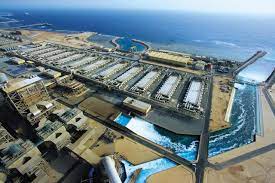The Middle East and North Africa account for some 48 percent of the world’s daily production of desalinated water, according to a report by BNC Intelligence.
Desalination is the process of removing salt and contaminants from sea water to produce fresh water.
The 4th MENA Desalination Projects 2023 Report details how a total of $39.3 billion is currently being spent on desalination projects across the region, whether planned or already underway. Saudi Arabia and the United Arab Emirates are investing the most of these countries, with a total of $14.58 billion and $10.28 billion worth of projects, respectively. According to the U.S.-Saudi Council, as much as 60 percent of the Kingdom’s water came from desalination in 2019, the majority of which was produced by the government-run Saline Water Conversion Corporation (SWCC).
As oil rich nations with access to sea water and the means to invest, both countries have projects in the pipeline, with Saudi Arabia having $7.56 billion worth of projects currently in concept, design and tender, while the UAE has $7.88 billion worth of projects oncoming, as reported by BNC Intelligence.
So, as droughts become more commonplace and the need to replenish supplies more urgent, why aren’t other countries investing as much in desalination?
Firstly, some other countries are, at least to an extent.
The United States had 167 plants in Florida, 52 in Texas and 58 in California as of 2018, according to the Updated and Extended Survey of U.S. Municipal Desalination Plants and announced in 2021 it would be investing $5 million in desalination technologies.
Australia and the United Kingdom are also among other affluent countries to own and use them, albeit none of these to the same scale of the plants in countries such as Saudi Arabia, the UAE and Israel.
Right now, desalination technologies have major limitations though, such as the fact the plants are extremely expensive to build and use, requiring a huge amount of energy to run.
At the same time, they produce toxic chemicals and large amounts of waste brine which is harmful to marine life and the environment, as well as greenhouse gas emissions if they run on diesel.

 Iran Energy News Oil, Gas, Petrochemical and Energy Field Specialized Channel
Iran Energy News Oil, Gas, Petrochemical and Energy Field Specialized Channel



